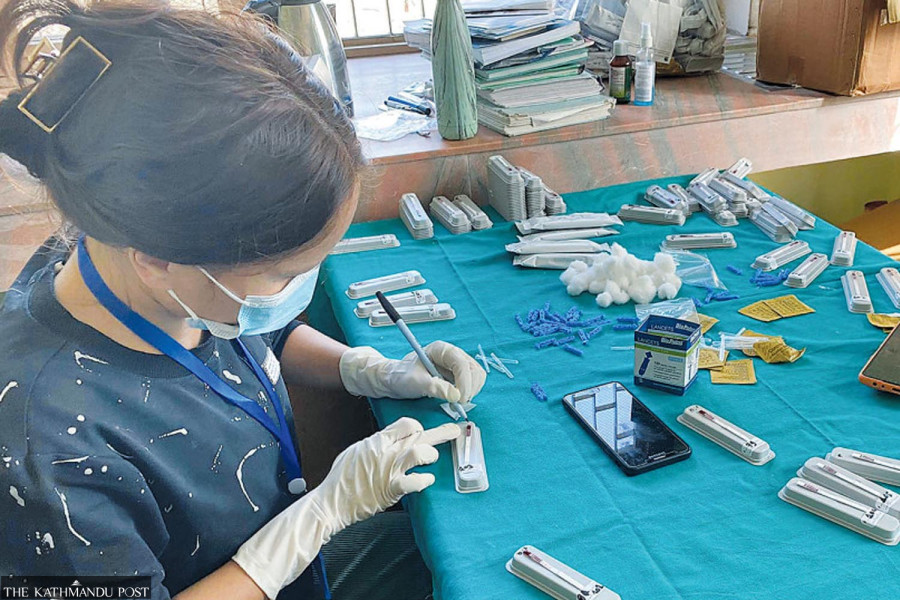Health
Elephantiasis still a concern in Baglung
Irregularity in prescribed drugs intake is a main reason it is still prevalent in the district, say health officials.
Prakash Baral
The Ministry of Health and Population plans to conduct a mass drug administration campaign against Lymphatic filariasis, commonly known as elephantiasis, in Baglung from mid-January next year. This is the fourteenth campaign launched in the district since 2009-2010 to control the spread of the disease.
Lymphatic filariasis is a mosquito-borne parasitic disease. The disease caused by filarial worms is transmitted by different species of mosquitoes, including Culex, Anopheles, and Aedes.
To declare the disease eradicated, the infection rate should be less than one percent. The government had committed to eliminating lymphatic filariasis as a public health problem by 2020. But the target could not be achieved due to low coverage of the programme in some districts—Baglung being one of them. The Health Ministry has extended the deadline to 2028 due to its failure to eliminate the disease in some districts.
The government started a mass drug administration programme to eliminate Lymphatic filariasis in 2003. Under the programme, healthy people above five years of age are given diethylcarbamazine and albendazole.
The percentage of people suffering from elephantiasis in Baglung stands at two percent, according to the Health Office in Baglung.
In Narayansthan, Baglung Municipality-14, where the number of infected people was high, a Transmission Assessment Survey (TAS) was conducted in 2020 on every patient to find out what went wrong. “The TAS revealed that most of the infected people did not take the medicines regularly,” said Ram Prasad Khanal, head of the Health Unit of Baglung Municipality. “That is why the disease is still not under control in the area.”
According to Khanal, a pre-transmission survey was also done in mid-November to identify the number of people suffering from elephantiasis in Baglung Municipality. The pre-transmission survey is a method of detecting the disease by testing the blood samples of every person from every household in a particular location. The survey showed two percent of people in Baglung were infected and more than 20 infected people have been identified in Narayansthan. Medicines for the disease have been distributed in the area regularly since the fiscal year 2009-2010.
Lakshmi Sharma, public health inspector at Health Office Baglung, showed a district-wide survey conducted in the fiscal year 2020-2021 that put the number of elephantiasis patients at 242 across the district. “We expect the number to decrease this year. Hopefully, the 14th drug administration campaign will bear good results,” she said.
“The infection which should have been eradicated years ago can still be seen in two percent of the population in the district. The challenges to eradicating the disease are aplenty but the most pressing one is negligence on the patient’s part,” said Sharma. “Most patients do not take medicines regularly. It is difficult to make people understand the necessity of taking medicines to eradicate the disease. When the health workers ask them, they say they will take medicines regularly but they don’t.”
Besides Narayansthan, symptomatic patients of elephantiasis have been found in Galkot, Badigad and other local units.
The World Health Organisation has identified the disease as a major public health problem, with an increasing prevalence worldwide. Nepal is one of the 73 countries in the world, where lymphatic filariasis is endemic. According to the UN health body, elephantiasis can be cured after five years of continuous medication but irregular intake of medicines will affect the efficacy of the medicines.
“A person who has taken the medicines regularly does not spread the infection and cannot transmit it to others. But in Baglung, controlling the disease is becoming a major problem because people don’t take the prescribed medicines,” said Sharma.
According to Chakra Bahadur Khatri, ward chairman of Baglung Municipality-14, the infection rate in the district has gone up in the last four years. “Four years ago, only 1.6 percent of the people were found infected in Baglung. Today two percent of the people are living with the disease. Apart from Narayansthan, a special campaign was conducted in Kushmisera of Jaimini Municipality, Dagatumdada and Gwalichour of Badigad Rural Municipality last year. These two areas are seeing an increase in the number of patients of elephantiasis,” said Khatri. “Volunteers, health workers and public representatives have been mobilised to identify the infected people and to provide them with medicines and treatment.”
According to Khanal, head of the Health Unit of Baglung Municipality, blood samples from 300 people will be collected and tested every day for elephantiasis and treatment of the infected will start immediately. “Blood test kits have arrived in Baglung. More than 450 health workers, 950 women health volunteers and more than 700 other volunteers will be deployed across the district for the mass drug administration campaign,” said Khanal.
Rambalak Yadav, a technician at the Vector Borne Disease Research and Training Centre, Hetauda, stresses the need for regular medication to meet the government’s target to eliminate the disease by 2028. “In 2018, the target to eliminate elephantiasis from Baglung was set for 2020, but the goal has not been met. We will now have to ensure every patient takes the medicines,” he said.




 10.12°C Kathmandu
10.12°C Kathmandu.jpg)














